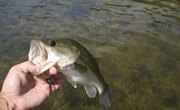
Electrofishing is a management tool used to analyze the quantity and type of fish in a pond, lake or river. The water is shocked by an electric current which temporarily paralyzes the fish, allowing them to be counted. However, electrofishing should not be performed without at least one experienced personnel and should not be performed in public lakes or rivers without prior confirmation from a local authority. Electrofishing equipment can be hired and professional biologists are also available to help shock your pond if you do not know anyone with relevant electrofishing experience.
Preparing for Electrofishing
Analyze your pond. You need to be aware of the size, depth and anything that may pose a risk to the electrofishing procedure (metal debris in the pond, etc.). You will need an extra person for every 10 feet of your pond length. You should also familiarize yourself with any laws, legislation or dangers regarding electrofishing before proceeding.
Wear clothing that is mostly free from metal, particulary on your shoes, and suitable for water and wet weather. Wear rubber shoes and gloves.
Gather your team and ensure you are all fully aware of your roles, any safety risks and the procedure. You must have at least one person experienced with electrofishing and electrofishing equipment. Biologists can be called out from your local authority to help with electrofishing; you can also call out students studying biology or electrofishing courses who will be willing to help with your survey.
Step up your equipment. Large ponds will require larger generators, and several electrodes spread apart down the pond by 10 feet. Your generator should be at one end of the pond and at least one member of your team should be located at the opposite end to catch any escaping fish.
Give each member of your team a large fishing net and a large bucket of water to place the fish in. Even those using the electrodes should be provided with a fishing net and bucket.
Electroshocking
Rubber footwear
Clothing without metal
Portable electrofishing generator
Large fishing net (see Tips)
Large buckets of water
You can hire electrofishing generators, nets and even clothing from local authorities or research centers. Speak to your local authority regarding electrofishing personnel and equipment.
For every two members of your team there should be at least one professional, biologist or experienced electrofishing person.
The pole of a fishing net should reach a quarter to half of the pond from land. Larger ponds will require more people positioned at the sides of the pond and on the opposite side of the generator.
Ensure you correctly measure water depth, density, length and width of your pond for an accurate current to be generated.
Do not use electrofishing equipment in public ponds, lakes or rivers. It is illegal to perform electrofishing in public areas without confirmation from local authorities and the presence of an electrofishing professional.
Do not attempt the procedure without a professional.
Familiarize yourself with safety risks, regulations and laws on electrofishing (see Resources).
Allow a professional or experienced member of your team to operate the generator. Once the generator is switched on a current— normally 250 volts — will be sent through the pond. The fish will shortly begin to rise to the surface.
Catch fish in your net once they begin to rise. Place the fish into the large bucket of water once caught in the net.
Allow time for fish to travel to the other end of the pond. If you are situated opposite the generator then fish may flee toward the other side of the pond. As the electricity moves throughout the pond, catch any fish coming toward you and place them in your own bucket.
Count the fish. A professional or experienced team member will normally oversee and assist in this step.
Place the fish back into the water. Once the generator is fully turned off, the fish may be returned and should completely recover.
Items you will need
Tips
Warnings
References
Writer Bio
Victoria Gorski has been a freelance copywriter since 2005, producing articles for small businesses, newspapers and magazines, as well as creating marketing material. She also publishes material for literacy communities and regional newspapers, such as the "MEN" and "Bolton News." Gorski is pursuing a Master of Arts in creative writing and a postgraduate certificate in education.



